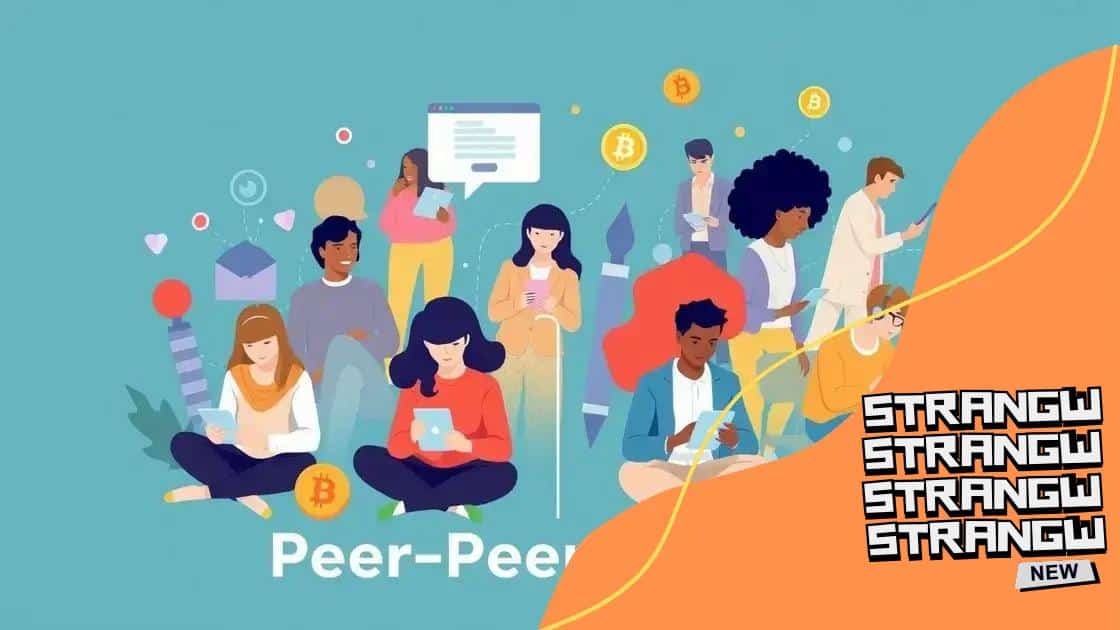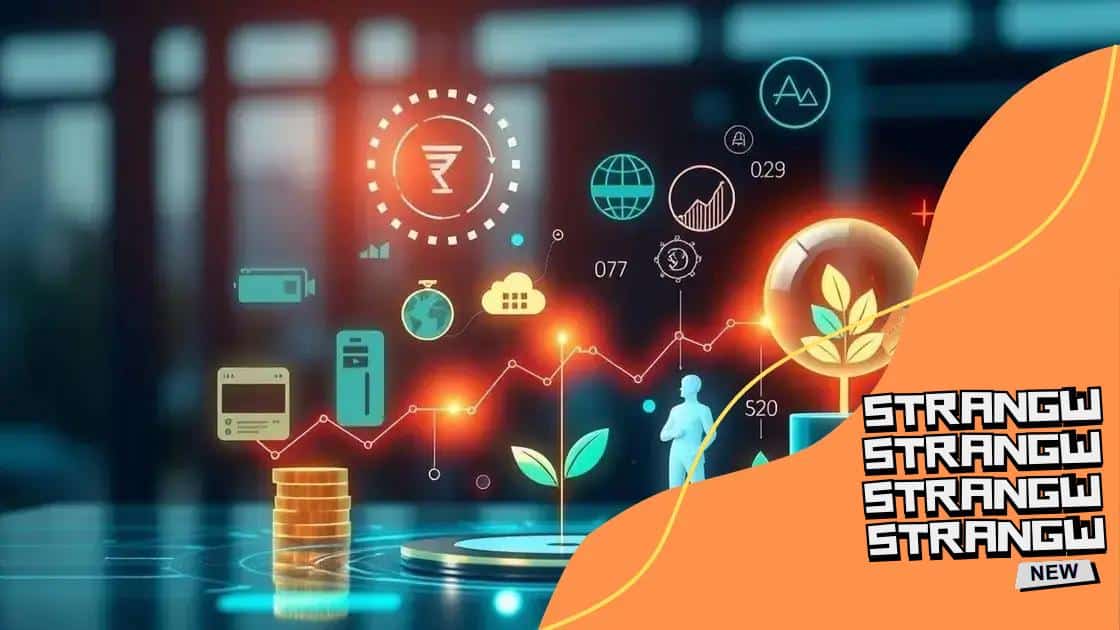The growth of peer-to-peer lending in 2025

The growth of peer-to-peer lending in 2025 is driven by advancements in technology, including AI and blockchain, offering benefits like lower rates for borrowers, higher returns for lenders, and increasing accessibility through mobile platforms.
The growth of peer-to-peer lending in 2025 is set to transform the financial landscape. Have you ever considered how this system could change your approach to borrowing or investing?
Understanding peer-to-peer lending
Understanding peer-to-peer lending is essential for anyone looking to navigate the modern financial landscape. This innovative system enables individuals to lend and borrow money directly from each other without the intervening role of traditional banks.
In essence, peer-to-peer lending connects investors with borrowers through online platforms. Borrowers can access loans more easily, while lenders have opportunities to earn better returns compared to conventional savings accounts. There are many benefits to consider.
Key benefits for borrowers
One of the main advantages for borrowers is the competitive interest rates. These rates are often lower than those offered by banks. Moreover, peer-to-peer lending can provide quicker approval times, allowing funds to be accessed almost immediately.
- Lower interest rates compared to banks.
- Faster funding approval.
- Access to loans with less stringent requirements.
On the other hand, lenders also enjoy distinct benefits. By lending money through these platforms, they can diversify their portfolios. Moreover, they can choose specific borrowers based on their creditworthiness preferences, creating a personalized investment strategy.
The role of technology
The technology behind peer-to-peer lending is another important factor. Online platforms use algorithms to assess risk and determine loan eligibility. This process involves collecting data from various sources, including credit scores and financial histories. Consequently, this allows for a fairer assessment and a wider reach for potential borrowers.
Furthermore, many peer-to-peer systems employ rigorous security measures to protect users. This encompasses encryption of personal information, ensuring that both parties can engage confidently.
Ultimately, peer-to-peer lending represents a shift towards a more democratized form of finance. As this sector continues to grow, it will likely influence traditional banking practices. Understanding these elements is vital if one wishes to take full advantage of the financial opportunities presented in this new landscape.
Key benefits for borrowers and lenders
Key benefits for borrowers and lenders make peer-to-peer lending an attractive option for many individuals. Understanding these benefits can help you maximize your financial opportunities.
For borrowers, one of the standout advantages is the access to loans with competitive interest rates. This can lead to significant savings over time. Additionally, the application process is often faster and less complicated than traditional banking methods, meaning borrowers can receive funds promptly to meet their needs.
Advantages for borrowers
- Lower interest rates, improving affordability.
- Quick approval times help alleviate urgent financial needs.
- Less stringent credit requirements for eligibility.
On the flip side, lenders also experience distinct benefits. They have the ability to earn higher returns on their investments compared to traditional banks. This is particularly beneficial in a low-interest-rate environment where conventional saving accounts yield minimal returns.
Advantages for lenders
Moreover, peer-to-peer lending allows lenders to diversify their investment portfolios. They can lend small amounts to different borrowers, mitigating risk while enhancing their potential for profit.
- Higher returns on investments.
- Opportunity to support individuals in need directly.
- Diversification across various loan offerings.
This system promotes a sense of community, where individuals can directly impact others’ financial situations. Borrowers benefit from quick access to funds, while lenders can take pride in helping others achieve their goals.
In essence, the benefits are mutually reinforcing, creating a win-win situation for both parties involved in peer-to-peer lending.
Emerging trends in 2025

Emerging trends in 2025 are shaping the future of peer-to-peer lending. As technology continues to evolve, we can expect significant changes in how this system operates.
One notable trend is the integration of advanced data analytics. Platforms are increasingly using big data to enhance loan assessments. This means quicker approvals and more accurate risk evaluations for both borrowers and lenders.
Increased automation
Another trend set to rise is automation. Many peer-to-peer platforms are adopting automated processes for loan originations. This not only speeds up the application process but also minimizes human errors.
- Faster loan processing times.
- More efficient customer service through AI.
- Reduction in operational costs.
Additionally, there is a growing focus on sustainability. Investors are becoming more aware of how their money impacts the environment. As a result, platforms may introduce eco-friendly lending options or prioritize projects that contribute to sustainability.
Regulatory changes
As the industry continues to develop, regulatory changes are likely. Governments may create new laws to better protect consumers and ensure transparency. This could lead to a more secure environment for both borrowers and lenders, improving overall trust in the system.
Moreover, the rise of cryptocurrencies is another trend to watch. As digital currencies gain popularity, platforms may incorporate cryptocurrency options to attract tech-savvy investors. This could broaden the investor base and introduce new financial opportunities.
In summary, as we approach 2025, these emerging trends will likely make peer-to-peer lending more accessible, efficient, and aligned with global sustainability goals. Awareness of these changes will be crucial for participants to capitalize on evolving opportunities.
Risks and considerations for investors
Risks and considerations for investors play a crucial role in the decision-making process within peer-to-peer lending. While there are opportunities for high returns, potential risks must be clearly understood.
One significant risk is the possibility of borrower defaults. Unlike traditional banks, peer-to-peer lending does not have the same level of safety nets. If a borrower fails to repay their loan, investors may lose their capital.
Key risks to consider
- Credit risk: The likelihood that a borrower will default on their loan.
- Liquidity risk: Difficulty in accessing funds quickly if needed.
- Market risk: Changes in interest rates can impact returns.
Additionally, investors should be aware of the platform’s credibility. Not all peer-to-peer lending platforms are the same. Some may have inadequate risk assessment processes, leading to high default rates.
Investment strategies to mitigate risks
To lower these risks, investors can diversify their portfolios. By spreading investments across multiple loans, they reduce the impact of one default on their total money invested.
- Investing in different types of loans.
- Funding smaller amounts across various borrowers.
- Evaluating borrower credit scores before investing.
Furthermore, conducting thorough research on the platform itself is vital. Looking into the platform’s track record, user reviews, and its approach to risk management can provide better insights into potential risks.
Ultimately, while peer-to-peer lending can be lucrative, it requires a careful approach. By understanding the risks and adopting suitable strategies, investors can navigate this modern lending landscape more effectively.
The future of peer-to-peer lending
The future of peer-to-peer lending is bright, with numerous advancements on the horizon. As technology evolves, so too will the opportunities available within this innovative lending model.
One major trend is the increasing use of blockchain technology. This decentralized approach can enhance transparency and security in transactions. It allows for almost instant fund transfers and reduces the need for intermediaries, which can lead to lower costs for borrowers and lenders.
Technological advancements
Furthermore, artificial intelligence is expected to play a significant role in assessing borrower creditworthiness. By analyzing large sets of data, AI can provide more accurate risk assessments, allowing lenders to make informed decisions.
- Improved risk evaluation using advanced algorithms.
- Faster loan approvals through automated processes.
- Personalized lending options based on borrower profiles.
Moreover, the rise in mobile applications will make peer-to-peer lending more accessible. As more people use smartphones, the convenience of applying for loans or investing in loans directly from mobile devices will attract a broader audience.
Impact of social responsibility
In addition, there is a growing emphasis on social responsibility. Investors are increasingly seeking platforms that support community development or sustainable initiatives. This trend may encourage platforms to adjust their offerings to attract socially-conscious investors.
As the industry matures, it’s likely that regulatory bodies will introduce new guidelines to ensure fairness and safety for participants. These regulations could also enhance the reputation of peer-to-peer lending, fostering trust among users.
Overall, the future of peer-to-peer lending promises to be transformative, with advancements in technology and a commitment to social responsibility playing pivotal roles. Understanding these trends will be critical for both borrowers and investors looking to participate in this evolving market.
In conclusion, peer-to-peer lending is shaping a new era in finance. With its innovative approach, it offers exciting opportunities for both borrowers and lenders. The merger of technology with social responsibility plays a critical role in making this system more efficient and user-friendly. As we move forward, staying informed about the emerging trends and risks will be essential. Engaging in peer-to-peer lending can be a rewarding experience when approached with careful consideration and understanding.
FAQ – Frequently Asked Questions about Peer-to-Peer Lending
What is peer-to-peer lending?
Peer-to-peer lending is a method that connects borrowers directly to individual lenders via online platforms, bypassing traditional banks.
What are the main benefits for borrowers?
Borrowers often benefit from lower interest rates and quicker loan approval compared to traditional banks.
How can lenders earn money through this model?
Lenders earn money by charging interest on the loans they provide to borrowers, potentially receiving higher returns than conventional savings accounts.
What risks should investors be aware of?
Investors should consider risks such as borrower defaults, platform reliability, and market fluctuations that can affect loan performance.





